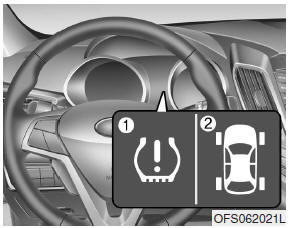 Hyundai Veloster: Tire pressure monitoring system (TPMS)
Hyundai Veloster 2011-2017 Owner's Manual / What to do in an emergency / Tire pressure monitoring system (TPMS)
Hyundai Veloster: Tire pressure monitoring system (TPMS)
Hyundai Veloster 2011-2017 Owner's Manual / What to do in an emergency / Tire pressure monitoring system (TPMS)

(1) Low tire pressure telltale / TPMS malfunction indicator
(2) Low tire pressure
position telltale
Each tire, including the spare (if provided), should be checked monthly when cold and inflated to the inflation pressure recommended by the vehicle manufacturer on the vehicle placard or tire inflation pressure label. (If your vehicle has tires of a different size than the size indicated on the vehicle placard or tire inflation pressure label, you should determine the proper tire inflation pressure for those tires.)
As an added safety feature, your vehicle has been equipped with a tire pressure monitoring system (TPMS) that illuminates a low tire pressure telltale when one or more of your tires is significantly under-inflated. Accordingly, when the low tire pressure telltale illuminates, you should stop and check your tires as soon as possible, and inflate them to the proper pressure. Driving on a significantly under-inflated tire causes the tire to overheat and can lead to tire failure. Under-inflation also reduces fuel efficiency and tire tread life, and may affect the vehicleŌĆÖs handling and stopping ability.
Please note that the TPMS is not a substitute for proper tire maintenance, and it is the driverŌĆÖs responsibility to maintain correct tire pressure, even if under-inflation has not reached the level to trigger illumination of the TPMS low tire pressure telltale.
Your vehicle has also been equipped with a TPMS malfunction indicator to indicate when the system is not operating properly. The TPMS malfunction indicator is combined with the low tire pressure telltale. When the system detects a malfunction, the telltale will flash for approximately one minute and then remain continuously illuminated. This sequence will continue upon subsequent vehicle start-ups as long as the malfunction exists. When the malfunction indicator is illuminated, the system may not be able to detect or signal low tire pressure as intended. TPMS malfunctions may occur for a variety of reasons, including the installation of replacement or alternate tires or wheels on the vehicle that prevent the TPMS from functioning properly. Always check the TPMS malfunction telltale after replacing one or more tires or wheels on your vehicle to ensure that the replacement or alternate tires and wheels allow the TPMS to continue to function properly.
✽ NOTICE
If the TPMS indicator does not illuminate for 3 seconds when the ignition switch is turned to the ON position or engine is running, or if it comes on after blinking for approximately one minute, take your car to your nearest authorized HYUNDAI dealer and have the system checked.
- Low tire pressure telltale
- TPMS (Tire Pressure Monitoring System) malfunction indicator
- Changing a tire with TPMS
 If the engine overheats
If the engine overheats
If your temperature gauge indicates overheating, you experience a loss of power,
or hear loud pinging or knocking, the engine is probably too hot. If this happens,
you should:
1. Pull off the roa ...
 Low tire pressure telltale
Low tire pressure telltale
When the tire pressure monitoring system warning indicator is illuminated, one
or more of your tires is significantly under-inflated.
If the telltale illuminates, immediately reduce your speed, a ...
See also:
Rear Washer Motor. Repair procedures
Inspection
1.
With the washer motor connected to the reservoir tank, fill the
reservoir tank with water.
...
Driver's and passenger's front air bag
Your vehicle is equipped with an Advanced Supplemental Restraint (Air Bag) System
and lap/shoulder belts at both the driver and passenger seating positions.
The indications of the system's pr ...
Repair procedures
Inspection
Manual Transaxle Oil
Inspection
1.
Park the vehicle on a level ground and stop the engine.
2.
Retighten the o ...
Categories
- Hyundai Veloster Manuals Home
- Hyundai Veloster 2010-2017 Owner's Manual
- Hyundai Veloster 2010-2017 Service Manual
